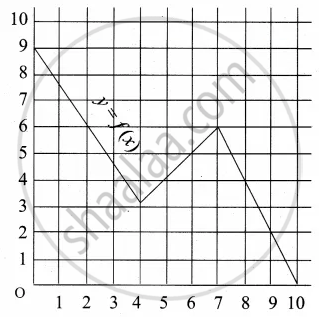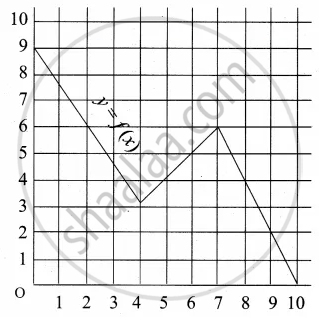Advertisements
Advertisements
Question
Answer the following:
If `log_2"a"/4 = log_2"b"/6 = log_2"c"/(3"k")` and a3b2c = 1 find the value of k
Solution
Let `log_2"a"/4 = log_2"b"/6 = log_2"c"/(3"k")` = R
∴ log2 a = 4R, log2 b = 6R, log2 c = 3kR
Now, a3b2c = 1
∴ log2 (a3b2c) = log2 1
∴ log2 a3 + log2 b2 + log2 c = 0
∴ 3 log2 a + 2 log2 b + log2 c = 0
∴ 3(4R) + 2(6R) +3kR = 0
∴ 12R + 12R + 3kR = 0
∴ 24R + 3kR = 0
∴ 3kR = – 24R
∴ k = – 8
APPEARS IN
RELATED QUESTIONS
Let f : R → R and g : C → C be two functions defined as f(x) = x2 and g(x) = x2. Are they equal functions?
Let X = {1, 2, 3, 4} and Y = {1, 5, 9, 11, 15, 16}
Determine which of the set are functions from X to Y.
(b) f2 = {(1, 1), (2, 7), (3, 5)}
If \[f\left( x \right) = \frac{x + 1}{x - 1}\] , show that f[f[(x)]] = x.
Let f(x) = x2 and g(x) = 2x+ 1 be two real functions. Find (f + g) (x), (f − g) (x), (fg) (x) and \[\left( \frac{f}{g} \right) \left( x \right)\] .
If f : Q → Q is defined as f(x) = x2, then f−1 (9) is equal to
If f(x) = cos (log x), then the value of f(x) f(y) −\[\frac{1}{2}\left\{ f\left( \frac{x}{y} \right) + f\left( xy \right) \right\}\] is
If f : R → R and g : R → R are defined by f(x) = 2x + 3 and g(x) = x2 + 7, then the values of x such that g(f(x)) = 8 are
The domain of the function \[f\left( x \right) = \sqrt{\frac{\left( x + 1 \right) \left( x - 3 \right)}{x - 2}}\] is
The domain of definition of \[f\left( x \right) = \sqrt{x - 3 - 2\sqrt{x - 4}} - \sqrt{x - 3 + 2\sqrt{x - 4}}\] is
The range of the function f(x) = |x − 1| is
If f(m) = m2 − 3m + 1, find f(−3)
Which of the following relations are functions? If it is a function determine its domain and range:
{(1, 1), (3, 1), (5, 2)}
Check if the relation given by the equation represents y as function of x:
x + y2 = 9
Find x, if g(x) = 0 where g(x) = `(5x - 6)/7`
Find x, if g(x) = 0 where g(x) = x3 − 2x2 − 5x + 6
Find the domain and range of the following function.
f(x) = `sqrt(16 - x^2)`
Check the injectivity and surjectivity of the following function.
f : N → N given by f(x) = x2
Express the following logarithmic equation in exponential form
log10 (0.001) = −3
Select the correct answer from given alternatives.
If f : R → R is defined by f(x) = x3 then f–1 (8) is equal to :
A function f is defined as : f(x) = 5 – x for 0 ≤ x ≤ 4. Find the value of x such that f(x) = 3
Answer the following:
Let f : R → R be given by f(x) = x + 5 for all x ∈ R. Draw its graph
Answer the following:
Simplify, log (log x4) – log (log x)
Answer the following:
If `log (("a" + "b")/2) = 1/2(log"a" + log"b")`, then show that a = b
Answer the following:
Find the domain of the following function.
f(x) = x!
Answer the following:
Find (f ° g) (x) and (g ° f) (x)
f(x) = `x/(x + 1)`, g(x) = `x/(1 - x)`
Given the function f: x → x2 – 5x + 6, evaluate f(2a)
A graph representing the function f(x) is given in it is clear that f(9) = 2

Describe the following Domain
A graph representing the function f(x) is given in it is clear that f(9) = 2

What is the image of 6 under f?
The data in the adjacent table depicts the length of a person's forehand and their corresponding height. Based on this data, a student finds a relationship between the height (y) and the forehand length (x) as y = ax + b, where a, b are constant.
| Length ‘x’ of forehand (in cm) |
Height 'y' (in inches) |
| 35 | 56 |
| 45 | 65 |
| 50 | 69.5 |
| 55 | 74 |
Find a and b
If f(x) = `(x - 1)/(x + 1), x ≠ - 1` Show that f(f(x)) = `- 1/x`, Provided x ≠ 0
The function f and g are defined by f(x) = 6x + 8; g(x) = `(x - 2)/3`
Write an expression for gf(x) in its simplest form
The domain of the function f(x) = `sqrtx` is ______.
If f(x) = `{{:(x^2",", x ≥ 0),(x^3",", x < 0):}`, then f(x) is ______.
Find the domain of the following functions given by f(x) = `1/sqrt(x + |x|)`
Find the domain of the following function given by:
f(x) = `(3x)/(2x - 8)`
Find the range of the following functions given by f(x) = 1 + 3 cos2x
(Hint: –1 ≤ cos 2x ≤ 1 ⇒ –3 ≤ 3 cos 2x ≤ 3 ⇒ –2 ≤ 1 + 3cos 2x ≤ 4)
Range of f(x) = `1/(1 - 2 cosx)` is ______.
The domain and range of the real function f defined by f(x) = `(4 - x)/(x - 4)` is given by ______.
The domain of the function f(x) = `sin^-1((|x| + 5)/(x^2 + 1))` is (–∞, –a] ≈ [a, ∞). Then a is equal to ______.
